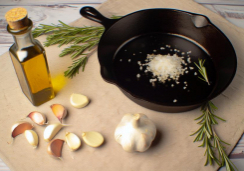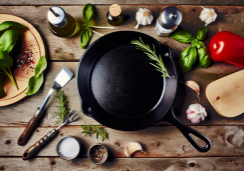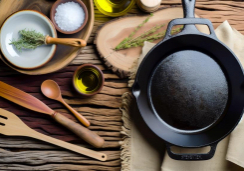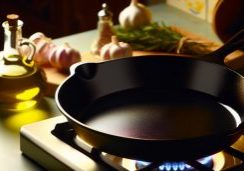5 Steps to Perfect Gluten-Free Baked Goods
Have you ever faced the crumbling disappointment of a gluten-free baking disaster? You're not alone.
Mastering the art of gluten-free baking is akin to an alchemist transforming base metals into gold, and it's your turn to unlock the secrets.
With precise steps, you can create treats that are just as tempting and satisfying as their wheat-based counterparts. As you embark on this journey, you'll learn to choose the right blend of flours, tweak the moisture to perfection, and handle your dough with the finesse of a seasoned baker.
But the path to gluten-free perfection doesn't end there; two more critical steps await, promising to elevate your baked delights from good to sublime.
Will your kitchen soon be filled with the aroma of flawless gluten-free breads and pastries? Only if you're ready to embrace the full spectrum of techniques that lie ahead.
Choose the Right Flour
Choosing the right gluten-free flour is often the key to transforming your baked goods from good to great. Each variety, from rice flour to tapioca starch, brings its unique properties to your recipes.
Rice flour, especially when it's from brown rice, offers a whole grain option that's finer than wheat flour and can absorb more liquid. This means you'll need to adjust your recipes slightly to avoid a dry result.
If you're aiming for a lighter texture, consider a flour blend. These pre-mixed combinations of gluten-free flours often balance heavier flours with lighter starches, such as tapioca starch, to mimic the properties of traditional wheat flour. Experimenting with different blends can lead to the best texture and taste for your specific needs. Remember to check the ingredients of store-bought blends, making sure they align with your recipe's requirements.
Lastly, don't forget binders like xanthan gum or guar gum. These are crucial in gluten-free baking to improve the structure and texture of your final product. Without these, your baked goods might crumble or fall apart. Use them sparingly to achieve that perfect consistency that's often missed in gluten-free treats.
Adjust Liquid Ratios
To ensure your gluten-free baked goods retain their moisture and avoid a dry, crumbly texture, it's essential to tweak the liquid ratios in your recipes. Gluten-free flours often call for more liquid than conventional ones because they tend to absorb more liquid. This means that when you're converting your favorite baking recipes to gluten-free, you can't just swap the flour; you must adjust the liquid ratios too.
When preparing gluten-free recipes, start by slightly increasing the amount of liquid the recipe calls for. This could be water, milk, or even fruit puree. The goal is to add moisture without making the batter too wet. Ingredients like xanthan gum or guar gum can help bind the mixture, mimicking gluten's properties and reducing the risk of a crumbly outcome.
Master Mixing Techniques
After adjusting the liquid ratios in your gluten-free recipes, it's equally important to refine your mixing techniques to achieve the desired texture and structure in your baked goods.
While traditional baking with all-purpose flour relies on kneading to develop the gluten, gluten-free baking requires a different approach since gluten-free flours often lack this protein.
Instead, you'll use binders like xanthan gum or guar gum to compensate for the absence of gluten. These binders help mimic the elastic properties of gluten, giving your baked goods the necessary structure.
To incorporate these into your flour blends effectively, you must master specific mixing techniques. For example, longer mixing times can improve the texture of your gluten-free baked goods, as it allows these binders to activate and create a network that traps air and adds volume.
Additionally, resting your batter before baking gives the gluten-free flours time to hydrate fully. This step is crucial because it leads to a smoother texture and a better overall structure.
Remember, gluten-free dough should look more like a sticky batter, and unlike gluten-containing dough, there's no need to knead.
Embracing these techniques will transform your gluten-free baking, resulting in perfect, delicious treats every time.
Perfect the Resting Period
Allow your gluten-free batter to rest for about 30 minutes before baking, as this crucial step helps the flours fully hydrate, softening the mixture and preventing a gritty texture in the final product. This resting period is particularly vital when using binders like xanthan gum or guar gum, which need time to activate and mimic gluten's structural properties.
While resting, the ingredients marry, enhancing flavor and ensuring a uniform texture throughout your baked goods. Don't rush this process; patience pays off. As the flours absorb moisture, they expand, which can lead to better volume and a more appealing crumb in cakes, cookies, and bread.
Remember to adjust baking times accordingly. The resting period can affect how quickly your items will bake. Sometimes, gluten-free recipes require a longer baking time at a lower oven temperature to achieve the perfect finish. Keep a close eye on the temperature and don't be afraid to let's know how your experiments go!
– Can Your 5 Steps to Perfect Gluten-Free Baked Goods Be Applied to Any Gluten-Free Baking Recipe?
Yes, the 5 steps to perfect gluten-free baked goods can be applied to any great gluten-free baking recipe. By focusing on using quality gluten-free flour blends, adding binders like xanthan gum or psyllium husk, incorporating moisture-rich ingredients, mixing well, and watching baking times, you can achieve delicious results every time.
What Are Some Additional Tips for Perfect Gluten-Free Baked Goods?
When it comes to gluten-free baking, there are a few key tips and recipes to keep in mind. First, try using a blend of gluten-free flours for better texture and taste. Adding xanthan gum can also improve the overall structure of your baked goods. Additionally, consider using applesauce or yogurt as a replacement for fats in recipes. With these glutenfree baking tips and recipes, you can perfect your gluten-free treats.
Adapt Baking Times
Understanding that gluten-free baked goods often need more time in the oven at a gentler heat will help you achieve the perfect texture and avoid underbaking. When you're preparing to bake, remember that gluten-free recipes may take longer to cook. To adapt baking times successfully, consider the role of ingredients like xanthan gum or guar gum, which can affect how your treats set and rise.
Start by following a recipe closely, but be prepared to adjust baking times based on the specific pan you're using—different materials conduct heat differently. Always check the manufacturer's advice for the pan at hand. Since gluten-free baked goods typically require a lower temperature, using an oven thermometer can ensure you're baking at the correct heat, preventing overbrowning or drying out.
Place your goods in the center of a pre-heated oven to promote even baking. Unlike traditional recipes, gluten-free versions often lack the structure that gluten provides, making them more reliant on leavening agents and precise temperatures. Pay attention to visual cues: a golden color, firm edges, and a toothpick inserted in the center coming out clean. These signs indicate that your baked goods may require a few more minutes to be fully done.
Conclusion
Now you're equipped to whip up delightful gluten-free treats! Remember, mix and match flours for the best texture, tweak liquid proportions for the ideal batter, and mix gently—no kneading needed.
Let your dough rest to reach peak softness, and adjust bake times for perfection. Don't forget, freeze your creations to keep them fresh.
Happy baking! You've got this down to a science, and your taste buds will thank you.
Get ready to impress with every gluten-free bite!










